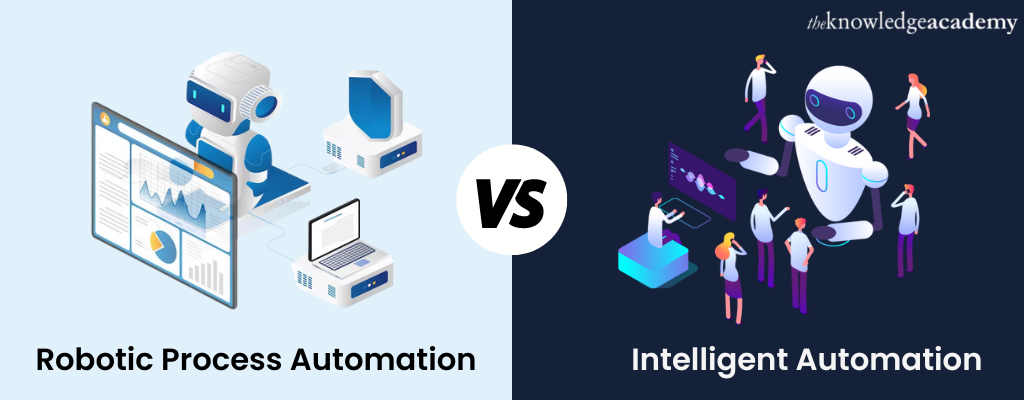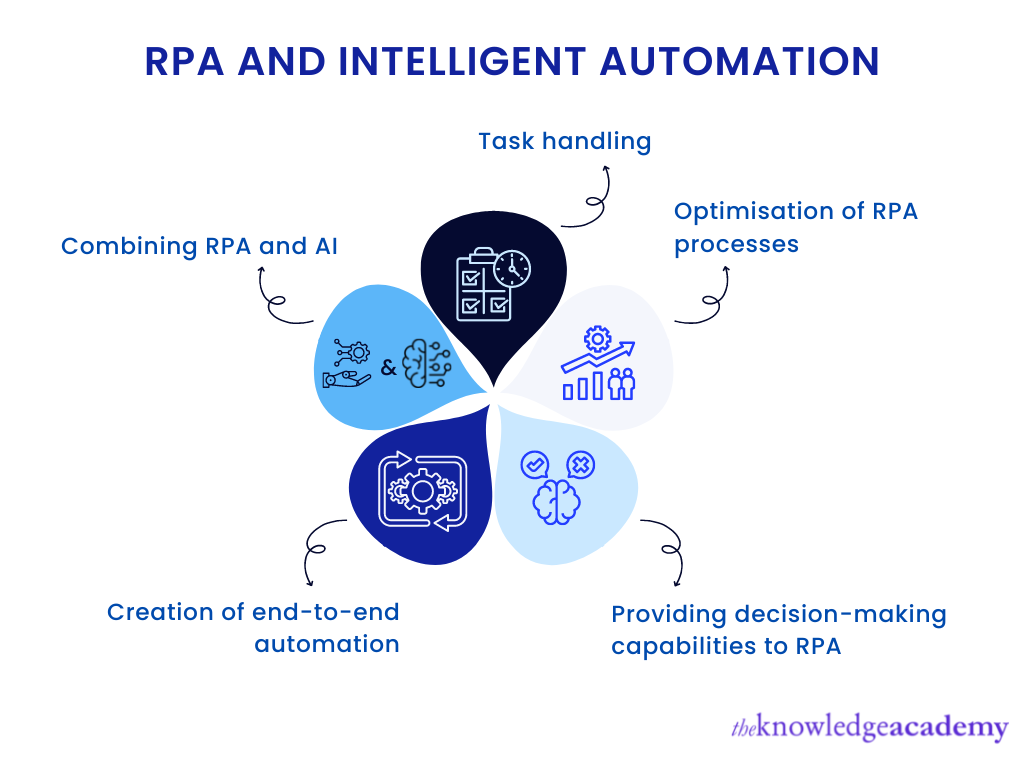We may not have the course you’re looking for. If you enquire or give us a call on +1 7204454674 and speak to our training experts, we may still be able to help with your training requirements.
Training Outcomes Within Your Budget!
We ensure quality, budget-alignment, and timely delivery by our expert instructors.

The business world is constantly evolving, with new technologies always emerging. One of the most significant developments in recent years has been the rise of Intelligent Automation and Robotic Process Automation (RPA). These technologies offer businesses powerful tools for automating their processes, improving efficiency and driving growth. The rise of these two technologies has led to an all-important debate: Intelligent Automation vs RPA; what do organisations worldwide consider more important?
For example, according to research, in 2021, the manufacturing industry was the top adaptor of RPA, with 31% of the entire industry worldwide adopting advanced technology. Similarly, more than half of the European and one-third of the Japanese and US-based manufacturers have adapted Intelligent Automation.
However, there are important distinctions between the two technologies that organisations have to understand before deciding what approach to take. In this blog, we’ll explore both the technologies, their benefits, the differences between RPA (Robotic Process Automation) and Intelligent Automation and how they can mutually co-exist with each other.
Table of Contents
1) Understanding Intelligent Automation and RPA
a) What is Intelligent Automation?
b) What is RPA?
2) What is the difference between RPA and Intelligent Automation?
3) Can RPA and Intelligent Automation co-exist?
4) Conclusion
Understanding Intelligent Automation and RPA
Before jumping into Intelligent Automation vs RPA as a topic, it is pivotal that we understand what these two technologies are and why they are important:
What is Intelligent Automation?
Intelligent Automation (IA) refers to a set of technologies that combine Robotic Process Automation (RPA) with Artificial Intelligence (AI) and Machine Learning (ML) capabilities. This allows systems to learn, adapt and optimise their performance over time, making them more intelligent and better able to handle complex tasks.
Intelligent Automation can be used in a wide range of applications, from customer service and sales to logistics and supply chain management. It enables businesses to automate more complex tasks, improve accuracy and enhance the customer experience.
The main benefits of Intelligent Automation are:
1) Enhanced accuracy and speed
2) Improved decision-making
3) Greater flexibility and scalability
4) Reduced costs and improved efficiency
5) Better customer experience
6) Increased competitiveness and agility
What is RPA?
Robotic Process Automation (RPA), on the other hand, is a type of software that uses bots or digital workers to automate repetitive and rule-based tasks. These tasks can include data entry, form-filling and other tasks requiring little human intervention.
RPA has been widely adopted by businesses in recent years to increase efficiency, reduce errors and free up employees to focus on more strategic tasks.
The main benefits of RPA are:
1) Reduced errors and improved accuracy
2) Increased productivity and efficiency
3) Lower costs and improved ROI
4) Greater scalability and flexibility
5) Improved compliance and risk management
Eager to learn more about Robotic Process Automation, refer to our blog on "RPA testing"
What is the difference between RPA and Intelligent Automation?
|
Aspect |
RPA |
Intelligent Automation |
|
Definition |
Software that automates repetitive, rule-based tasks using pre-defined logic and rules. |
Advanced software that combines RPA, machine learning and other cognitive technology to automate complex business processes with the ability to learn and adapt to new situations. |
|
Goal |
Focuses on automating routine, repetitive and manual tasks that follow pre-defined rules. |
Covers a wide range of business processes and decision-making with the ability to learn and adapt to new situations. |
|
Scope
|
Focuses on automating routine, repetitive tasks that follow a set of pre-defined rules. |
Covers a wide range of business processes that involve complex decision-making, data analysis and communication. |
|
Cognitive abilities |
Lacks cognitive abilities beyond pre-defined rules and logic. |
Advanced cognitive abilities allow it to learn from past actions and adapt to new situations. |
|
Decision-making |
Limited to pre-defined rules and logic. |
Has the ability to make decisions based on Machine Learning and data analysis. |
|
Integration with other technologies |
Can be integrated with other technologies, such as OCR and APIs. |
Combined multiple technologies such as RPA, Machine Learning and cognitive computing to automate complex processes. |
|
Implementation |
Easier to implement, with minimal disruption to existing processes. |
May require significant changes to existing processes and systems to leverage its capabilities fully. |
|
Benefits |
Reduces errors, increases speed and accuracy and lowers operational costs. |
Improves process efficiency, reduces errors, enables better decision-making and enhances customer experience. |
|
Use Cases |
Commonly used in finance, architecture, healthcare and manufacturing industries for tasks like data entry, invoice processing and customer service. |
Used in banking, insurance and healthcare industries for more complex processes such as claims processing, fraud detection and compliance monitoring. |
Can RPA and Intelligent Automation co-exist?

Intelligent Automation and RPA can co-exist in a variety of ways, and they can even complement each other in many scenarios. Here are a few examples:
1) Combining RPA and AI: RPA can be used to automate repetitive, rule-based tasks, while AI can be used to add intelligence to the process. For example, an RPA Bot can extract data from a document, while an AI-powered algorithm can analyse the data to make decisions or predictions.
2) Task handling: RPA can automate simple, routine and repetitive tasks, while human employees can focus on complex tasks that require creativity and decision-making and involve human interaction.
3) Implement Intelligent Automation to optimise RPA processes: Intelligent Automation can be used to improve the performance and efficiency of RPA processes. For example, Machine Learning algorithms can identify patterns and optimise RPA workflows.
4) Using Intelligent Automation to provide context and decision-making capabilities to RPA: Intelligent Automation can provide additional context and decision-making capabilities to RPA Bot. For example, Natural Language Processing (NLP) can make RPA Bots understand unstructured data or language and make decisions based on the executed data.
5) Combining Intelligent Automation and RPA to create end-to-end process automation: Intelligent Automation and RPA can automate end-to-end business processes. For example, an RPA Bot could extract data from a document. An AI algorithm can analyse the data; another RPA Bot could use the analysis results to automate a subsequent task.
Understand the basics of RPA to build your first Blue Prism Process. Sign up for our Blue Prism Training course now!
Some use cases where Intelligent Automation and RPA have been used together are:
1) Financial Services: RPA can automate repetitive tasks such as data entry, while Intelligent Automation can provide decision-making capabilities. For example, an RPA Bot could process loan applications, while an AI algorithm could be used to determine creditworthiness.
2) Healthcare: RPA can be used to automate administrative tasks such as appointment scheduling, while Intelligent Automation can be used to provide context and decision-making capabilities. For example, an RPA Bot could schedule appointments, while an AI algorithm could be used to determine the urgency of the appointment based on the patient’s symptoms.
3) Manufacturing: RPA can be used to automate tasks such as data entry or quality control checks, while Intelligent Automation can be used to optimise production capability logs, while an AI algorithm could be used to analyse the data and identify areas of improvement and effectiveness.
4) Retail: RPA can be used to automate tasks such as Inventory Management or order processing, while Intelligent Automation can be used to provide decision-making capabilities. For example, an RPA Bot could manage inventory levels, while an AI algorithm could be used to predict demand and optimise inventory levels.
5) Employee Onboarding: RPA can be used to ease tasks such as long processes and paperwork, while Intelligent Automation can be used to automate the entirety of the onboarding processes. For example, an RPA Bot could manage the basic paperwork of a candidate being onboarded. In contrast, an AI algorithm could be used to automate the other pivotal essentials of the candidate, such as IT system and regulation compliance.
6) Customer Relationship Management (CRM): RPA can automate tasks such as data entry and template/standard replies to customer queries and grievances, while Intelligent Automation can track vital statistics such as customer trends and behaviour. For example, an RPA Bot could manage standard chatbot-like replies to customer queries. In contrast, an AI algorithm could regulate and transform the feedback into visualised graphs and charts for future use.
Conclusion
Intelligent Automation and Robotic Process Automation (RPA) both offer powerful tools for automating business processes and improving the efficiency of an organisation. While RPA is used to automate simple and repetitive tasks, Intelligent Automation is better suited to automating more complex, data-driven tasks.
Businesses should carefully evaluate their needs and goals when deciding which approach to take. Those that require more advanced automation capabilities and want to achieve greater flexibility, scalability and intelligence may find that Intelligent Automation is the better choice. Those that want to automate specific, rule-based processes and achieve incremental efficiency improvements may find RPA more suitable to their organisation.
Explore the goals of automation testing with the Software Testing and Automation Training course. Sign up now!
Frequently Asked Questions
Upcoming Business Analysis Resources Batches & Dates
Date
 Robotic Process Automation using UiPath
Robotic Process Automation using UiPath
Thu 9th Jan 2025
Thu 13th Mar 2025
Thu 12th Jun 2025
Thu 7th Aug 2025
Thu 18th Sep 2025
Thu 27th Nov 2025
Thu 18th Dec 2025







 Top Rated Course
Top Rated Course



 If you wish to make any changes to your course, please
If you wish to make any changes to your course, please


